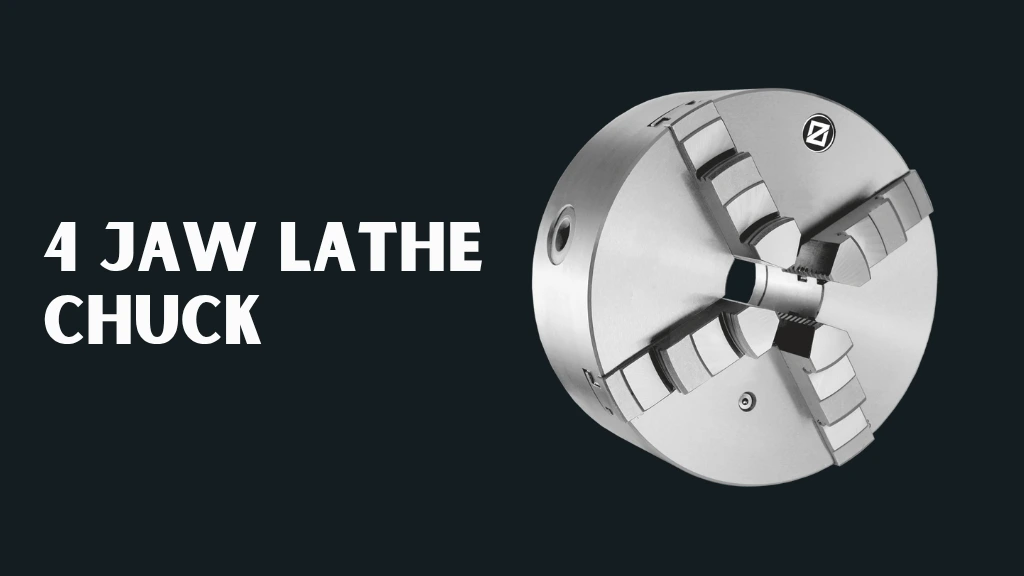A 4 jaw lathe chuck is a versatile tool that provides machinists, metalworkers, and woodturners with unmatched control and precision when holding workpieces. Its design allows for secure clamping of round, square, or irregularly shaped materials, making it suitable for a wide range of turning and machining operations. This adaptability ensures that even complex or off-center workpieces can be machined accurately without compromising safety or stability.
In addition to its functional benefits, a 4 jaw chuck enables craftsmen to achieve professional-quality results while maintaining efficiency. Understanding the features, advantages, proper maintenance, and practical applications of this tool is essential for anyone looking to enhance their machining capabilities and produce consistent, precise outcomes.
What Is a 4 Jaw Lathe Chuck
A 4 jaw lathe chuck is a clamping device used to hold a workpiece securely on a lathe. Unlike the more common 3-jaw chuck, which automatically centers the workpiece, the 4-jaw chuck has four independent jaws that can be adjusted individually. This design allows for precise alignment and enables the clamping of irregularly shaped or off-center workpieces with high accuracy.
The independent jaw adjustment makes 4-jaw chucks particularly valuable in situations where precise centering is critical. This capability is essential in metalworking industries, custom woodworking projects, and other precision machining applications. For machinists who require a higher level of control over the workpiece, the 4 jaw chuck is an invaluable tool.
Types of 4 Jaw Chucks
4 jaw chucks are essential tools for machinists, providing flexibility for different workpiece shapes. Understanding the main types helps professionals select the right chuck for precision tasks. Choosing the correct type ensures consistent results and prevents errors during complex machining operations. Experienced machinists often rely on these chucks for high-accuracy projects in metalworking and woodworking industries.
Independent 4 Jaw Chucks
An independent 4 jaw chuck allows each jaw to move separately, giving full control over workpiece alignment. This flexibility is critical when machining irregular or off-center components that standard chucks cannot handle. Professional workshops use independent chucks to achieve high precision, especially in aerospace and custom manufacturing. Real-world experience shows that independent jaws reduce waste and improve part quality significantly.
Self-Centering 4 Jaw Chucks
Self-centering 4 jaw chucks move two opposing jaws at the same time, automatically centering the workpiece. They are ideal for square or rectangular stock, offering convenience without sacrificing moderate precision. Many industrial machinists choose self-centering chucks for routine operations where speed and consistency are important. Case studies indicate that they reduce setup time while maintaining reliable accuracy for standard geometries.
Advantages of Using a 4 Jaw Chuck
One of the main benefits of a 4 jaw lathe chuck is its ability to provide precise centering, even for irregular or off-center workpieces. By adjusting each jaw individually, machinists can achieve exact alignment, ensuring accuracy in every operation. This level of control is difficult to replicate with a standard 3-jaw chuck, making it indispensable for high-precision machining. Experienced professionals in metalworking and woodworking consistently rely on this feature for complex projects.
Another significant advantage is the versatility of these chucks. They can securely hold round, square, or uniquely shaped workpieces, allowing machinists to handle a variety of tasks without changing clamping tools. Workshops that frequently switch between materials and shapes benefit from this flexibility, as it streamlines workflow and reduces setup time. Real-world applications in custom manufacturing show that versatility directly contributes to efficiency and reduced material waste.
Durability and secure holding are also key strengths. High-quality 4 jaw chucks are usually made from hardened steel or cast iron, providing long-term reliability under heavy-duty conditions. The independent jaw adjustment ensures a firm grip, minimizing slippage and enhancing safety, especially during high-speed or precise operations. Professionals in aerospace, automotive, and industrial machining industries often highlight these chucks for delivering superior tolerances and consistent surface finishes.
Key Features to Consider When Selecting a 4 Jaw Chuck
The material of the jaws is one of the most critical factors when selecting a 4 jaw chuck. High-quality options made from hardened steel or cast iron provide durability and maintain precise alignment even under heavy-duty use. Choosing a reliable material ensures long-term accuracy, which is particularly important in professional workshops where consistency is essential. Experienced machinists emphasize that investing in a durable chuck reduces maintenance and replacement costs over time.
Chuck size and mounting type are also essential considerations. The chuck must match the lathe’s specifications and accommodate the workpiece size for stability and effective gripping. A chuck that is too small may fail to hold larger components securely, while an oversized chuck could cause alignment issues or exceed spindle capacity. Similarly, understanding whether the chuck mounts directly onto the spindle or requires an adapter is crucial to maintain safety and operational efficiency.
Jaw type and additional accessories further impact performance. Standard jaws meet general machining needs, but specialized jaws, such as dovetail or custom-shaped jaws, provide greater control for irregular or intricate workpieces. Accessories like backplates or adapters enhance stability and alignment, which is particularly valuable during heavy-duty or precision operations. Professional machinists often recommend selecting a chuck with versatile jaw options and compatible accessories to optimize workflow and achieve consistent results.
How to Use a 4 Jaw Chuck
Using a 4 jaw lathe chuck begins by securely mounting it onto the lathe spindle. Proper alignment at this stage is essential to maintain precision during all machining operations. Once the chuck is mounted, the workpiece is carefully placed inside, ensuring it sits stable and centered. Experienced machinists emphasize the importance of this step to prevent misalignment that could affect the final results.
Each jaw is then adjusted individually, usually starting from opposite sides to evenly distribute pressure across the workpiece. This approach prevents tilting or uneven clamping, which could compromise accuracy and surface finish. A dial indicator is often used to verify that the workpiece is perfectly centered. Skilled machinists make fine adjustments as needed to achieve precise alignment before starting the operation.
After centering, machining processes such as turning, facing, or drilling can proceed. It is important to monitor the chuck and workpiece during operations to ensure secure clamping and consistent performance. Proper use of the 4-jaw chuck enhances both precision and safety, reducing the risk of slippage and improving the overall quality of the machined part.
Maintenance Tips for Longevity
Maintaining a 4 jaw chuck is essential for preserving its accuracy and extending its lifespan. Regular cleaning is crucial to remove metal chips, dust, and other debris that could interfere with jaw movement. Lubricating the threads and moving parts reduces friction and prevents wear, ensuring smooth operation.
Periodic inspections help identify cracks, wear, or misalignment. Any damaged components should be replaced promptly to maintain precision and prevent operational issues. Proper storage is also important. Chucks should be kept in a dry environment to prevent rust and corrosion, which could compromise their performance over time. By following these maintenance practices, machinists can ensure that their 4-jaw chucks continue to perform reliably over the years.
Case Study
PrecisionWorks, a custom manufacturing shop, faced a challenging project involving off-center, irregularly shaped aluminum components for aerospace assemblies. The parts required extremely tight tolerances and precise alignment to meet strict industry safety standards. Using a traditional 3-jaw chuck was not feasible, as it could not hold the irregular workpieces securely, which would have led to misalignment and potential defects. The team needed a solution that combined flexibility, accuracy, and reliability for high-precision machining.
The machinists chose an independent 4 jaw chuck, adjusting each jaw individually and using a dial indicator to ensure perfect centering. This approach allowed the shop to achieve tolerance levels of ±0.02 mm, complete the project ahead of schedule, and prevent slippage during operations. The components met all safety requirements, and the surface finish was excellent. This case demonstrates the precision, versatility, and professional-grade reliability that independent 4 jaw chucks provide in demanding manufacturing environments.
Conclusion
A 4 jaw lathe chuck is an essential tool for machinists, woodturners, and professionals who demand precision, secure holding, and versatility. Understanding its types, advantages, proper maintenance, and practical applications allows users to select the right chuck for their specific machining needs. Experienced operators rely on this knowledge to ensure consistent results and avoid errors during complex projects.
High-quality 4 jaw chucks deliver long-term reliability and professional-level outcomes in a variety of settings, from aerospace components to custom metalworking and woodworking. Proper use and regular maintenance enhance accuracy, minimize material waste, and boost productivity. Industry professionals consistently recommend investing in a durable chuck to achieve superior tolerances and maintain consistent performance over time.
FAQs
Can a 4 jaw chuck hold irregularly shaped workpieces?
Yes. Independent jaw adjustment allows a 4 jaw chuck to securely grip irregular or off-center workpieces, which is not possible with standard 3-jaw chucks.
How do I achieve precise centering?
Adjust each jaw individually and use a dial indicator to check alignment until the workpiece is perfectly centered.
Are 4 jaw chucks suitable for beginners?
While more complex than self-centering chucks, beginners can benefit from learning to use 4 jaw chucks. Mastery provides flexibility and precision for advanced projects.
How often should I maintain my 4 jaw chuck?
After every project, clean the chuck and perform periodic lubrication and inspection to maintain performance and longevity.
Can 4 jaw chucks be used in woodworking?
Yes. They are often used in woodworking lathes for holding square or irregular stock securely while performing turning operations.




